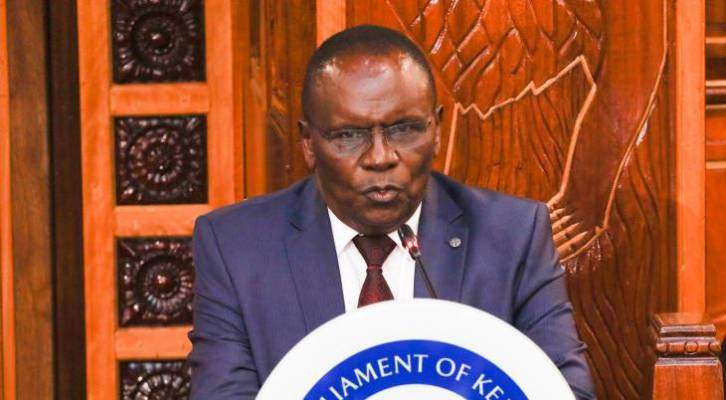By JUMA KWAYERA
As testimony of the sensitivity of land issues in the country, the High Court in Nairobi has referred a longstanding dispute between the Maasai community and the Ministry of Forestry and Wildlife to Chief Justice for arbitration.
Following a ruling last Friday by Lady Justice Mumbi Ngugi, Chief Justice Willy Mutunga is expected to constitute a three-judge bench to hear the case in which the Maasai want to be allowed to settle on the outskirts of the forest, which the community regards as a sacred grove.
Lady Justice Ngugi referred the dispute to Mutunga after the Ministry of Forestry and Wildlife, which falls under the Kenya Forest Service (KFS) that planned to evict more than 600 families from the area but failed to move after ban on settlements in the ecosystem.
The decision to submit the matter to the chief justice has been supported by both parties. The Maasai seek to uphold their right to stay on the 3,000-hectare land based on a crown law of 1949 and trust land law of 1963. They contend that in 1984 former President Daniel arap Moi set the land aside for a human settlement and grazing, a decision that was confirmed in 2005 by President Kibaki.
In her ruling, the judge acknowledged the matter was weighty, hence the need to be heard by a three-judge bench. The development has echoes of a protracted legal tussle pitting the State against the Ogiek communities, which successfully planned evictions from the Mau Forest complex on the basis of the forests being shrines. The two entered a deal to conserve the forest in exchange for settlement.
In the Ngong Hills saga, the Maasai had been granted the rights to settle within 400 metres of the forest through a 1984 presidential decree, but the KFS has declined to implement the directive citing environmental destruction. Instead, the KFS wants the community barred from accessing the forest, leave alone settlement.
The petition was filed by veteran politician John Keen on behalf of the pastoralists, who as result of stringent environmental protection regimes would be ejected from their ancestral land. They argue that the land is communally owned.
Mr Keen told The Standard On Saturday the judge made a sound decision to refer the dispute to the Chief Justice and that the composition of a three-judge bench to hear the case would bring it to a logical conclusion.
"This will help resolve the matter that has been pending for more than two decades. I brought up his matter in 1984 before the retired president, whom I requested to allow the Maasai to inhabit up to 400 metres of the land adjacent to the Ololaisar (Ngong Hills)," he said.
Following the pastoralists’ petition, the retired president directed, under the old constitution, that the Maasai utilise the grazing land up to Oltakeiny. It was intended to provide room for the Maasai who live a more sedentary life by building permanent homes, churches and schools on the land, roughly 60 kilometres south of Nairobi.
The region has been depleted of vegetation cover thanks to charcoal burning and other unsustainable forms of utilitisation of the forest. The biodiversity is rich in floral and faunal resources, the most known being the lions, giraffes, various species of African antelopes and rare birds, among others.
In the countdown to the 2005 referendum and 2007 General Election, President Kibaki too supported the Maasai’s push to settle in the areas around the hills, which they regard as an ancestral shrine.
Historically, the last Maasai’s laibon (chief) Sae Kedongoi descended from the Ngong Hills to preside over one of the most culturally conservative African communities in Africa. The laibon later died in a manyatta (kraal) on the slopes of the hills.
However, the rapid expansion of Nairobi southwards has increasingly pushed the Maasai away from their settlements. The transformation of the plains has accelerated rapid deforestation and destruction of vegetation cover.
Stay informed. Subscribe to our newsletter
The Maasai consider Ngong Hills their ancestral land Keen says the Maasai will no longer be tossed around and deprived and dispossessed by post-independence governments.
He says it is ironical that while the State is in the process of resettling people uprooted from their homes by post-election violence in 2008, it is at the same time creating an another mass of the homeless through selective and discriminatory interpretation of the rights.
"I see no reason why the Maasai should be displaced from Ngong Hills by three successive governments. I would like to appeal to Dr Noah Wekesa (Minister for Forestry and Wildlife) together with the director of KFS Dr David Mbugua to abandon the idea," he states.
The Maasai leaders want the issue resolved in a tripartite manner, taking into account the Forestry Act, 2005, to establish community participation. The Act provides that communities leaving adjacent to Government-protected areas can be allowed to participate in conservation through registered community associations or organisations.
Dr Wekesa did not answer telephone calls after promising to give his ministry’s position on the dispute.
Clause 46 of the Act says an association approved by the Director of Forestry can be allowed to participate in the management or conservation of a forest or part of a forest.
Such associations, the law provides, can be co-opted by the forestry service to "protect, conserve and manage such forest or part thereof pursuant to an approved management agreement entered into under this Act and the provisions of the management plan for the forest."
The partnerships also provide for formulation and implementation of "forest programmes consistent with the traditional forest user rights of the community concerned in accordance with sustainable use criteria."
The law also protects sacred groves and protected trees. It is against this backdrop that the Maasai are challenging the eviction by the forest service.
"With the approval of the board, they can enter into partnerships with other persons for the purposes of ensuring the efficient and sustainable conservation and management of forests, keep the service informed of any developments, changes and occurrences within the forest, which are critical for the conservation of biodiversity," the Act says.
The involvement of the community in the conservation of the forest is expected to translate into sedentary settlements in addition to reducing frequent wildlife-human conflicts. The forest reserve has for a long time been regarded as a key purifier of gaseous emissions from industries in Nairobi.
The reduction of the forest cover has meant the gases remain trapped in the atmosphere for a long time, thereby affecting the acidity level of the rains received in the adjoining areas.
 The Standard Group Plc is a
multi-media organization with investments in media platforms spanning newspaper
print operations, television, radio broadcasting, digital and online services. The
Standard Group is recognized as a leading multi-media house in Kenya with a key
influence in matters of national and international interest.
The Standard Group Plc is a
multi-media organization with investments in media platforms spanning newspaper
print operations, television, radio broadcasting, digital and online services. The
Standard Group is recognized as a leading multi-media house in Kenya with a key
influence in matters of national and international interest.
 The Standard Group Plc is a
multi-media organization with investments in media platforms spanning newspaper
print operations, television, radio broadcasting, digital and online services. The
Standard Group is recognized as a leading multi-media house in Kenya with a key
influence in matters of national and international interest.
The Standard Group Plc is a
multi-media organization with investments in media platforms spanning newspaper
print operations, television, radio broadcasting, digital and online services. The
Standard Group is recognized as a leading multi-media house in Kenya with a key
influence in matters of national and international interest.









